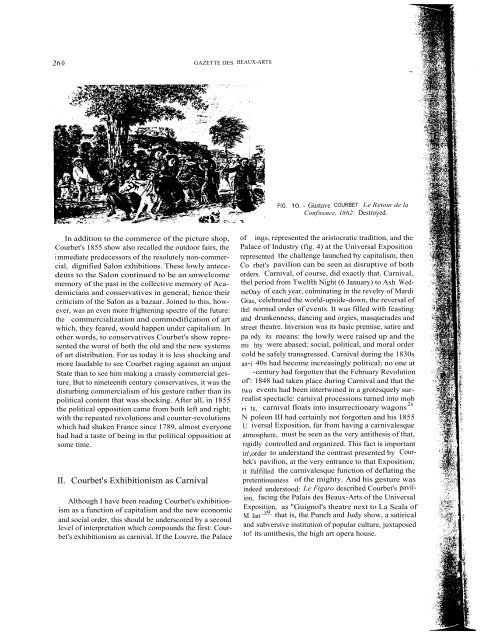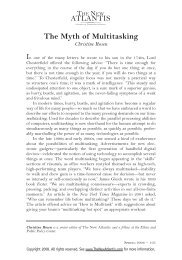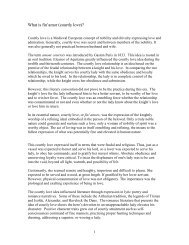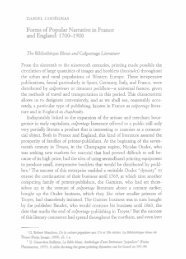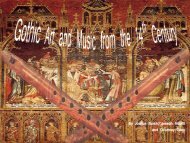Courbet's Exhibitionism
Courbet's Exhibitionism
Courbet's Exhibitionism
You also want an ePaper? Increase the reach of your titles
YUMPU automatically turns print PDFs into web optimized ePapers that Google loves.
26 0<br />
In addition to the commerce of the picture shop,<br />
<strong>Courbet's</strong> 1855 show also recalled the outdoor fairs, the<br />
immediate predecessors of the resolutely non-commercial,<br />
dignified Salon exhibitions. These lowly antecedents<br />
to the Salon continued to be an unwelcome<br />
memory of the past in the collective memory of Academicians<br />
and conservatives in general; hence their<br />
criticism of the Salon as a bazaar. Joined to this, however,<br />
was an even more frightening spectre of the future:<br />
the commercialization and commodification of art<br />
which, they feared, would happen under capitalism. In<br />
other words, to conservatives <strong>Courbet's</strong> show represented<br />
the worst of both the old and the new systems<br />
of art distribution. For us today it is less shocking and<br />
more laudable to see Courbet raging against an unjust<br />
State than to see him making a crassly commercial gesture.<br />
But to nineteenth century conservatives, it was the<br />
disturbing commercialism of his gesture rather than its<br />
political content that was shocking. After all, in 1855<br />
the political opposition came from both left and right;<br />
with the repeated revolutions and counter-revolutions<br />
which had shaken France since 1789, almost everyone<br />
had had a taste of being in the political opposition at<br />
some time.<br />
II. <strong>Courbet's</strong> <strong>Exhibitionism</strong> as Carnival<br />
GAZETTE DES BEAUX-ARTS<br />
Although I have been reading <strong>Courbet's</strong> exhibitionism<br />
as a function of capitalism and the new economic<br />
and social order, this should be underscored by a second<br />
level of interpretation which compounds the first: <strong>Courbet's</strong><br />
exhibitionism as carnival. If the Louvre, the Palace<br />
FIG. 10. - Gustave COURBET. Le Retour de la<br />
Confirence, 1862. Destroyed.<br />
of ings, represented the aristocratic tradition, and the<br />
Palace of Industry (fig. 4) at the Universal Exposition<br />
represented the challenge launched by capitalism, then<br />
Co rbet's pavilion can be seen as disruptive of both<br />
orders. Carnival, of course, did exactly that. Carnival,<br />
thel period from Twelfth Night (6 January) to Ash Wedne0ay<br />
of each year, culminating in the revelry of Mardi<br />
Gras, celebrated the world-upside-down, the reversal of<br />
thel normal order of events. It was filled with feasting<br />
and drunkenness, dancing and orgies, masquerades and<br />
street theatre. Inversion was its basic premise, satire and<br />
pa ody its means: the lowly were raised up and the<br />
mi hty were abased; social, political, and moral order<br />
cold be safely transgressed. Carnival during the 1830s<br />
an~i 40s had become increasingly political; no one at<br />
-century had forgotten that the February Revolution<br />
of': 1848 had taken place during Carnival and that the<br />
two events had been intertwined in a grotesquely surrealist<br />
spectacle: carnival processions turned into mob<br />
2s<br />
ri<br />
N<br />
U<br />
atmosphere, must be seen as the very antithesis of that,<br />
rigidly controlled and organized. This fact is important<br />
in',order to understand the contrast presented by Courbek's<br />
pavilion, at the very entrance to that Exposition;<br />
it I,fulfilled the carnivalesque function of deflating the<br />
pretentiousness of the mighty. And his gesture was<br />
indeed understood: Le Figaro described <strong>Courbet's</strong> pavilion,<br />
facing the Palais des Beaux-Arts of the Universal<br />
Exposition, as "Guignol's theatre next to La Scala of<br />
M lan ..z9 , ts, carnival floats into insurrectionary wagons<br />
poleon III had certainly not forgotten and his 1855<br />
iversal Exposition, far from having a carnivalesque<br />
that is, the Punch and Judy show, a satirical<br />
and subversive institution of popular culture, juxtaposed<br />
to! its antithesis, the high art opera house.


